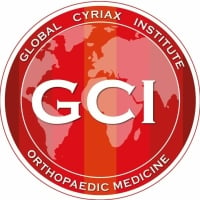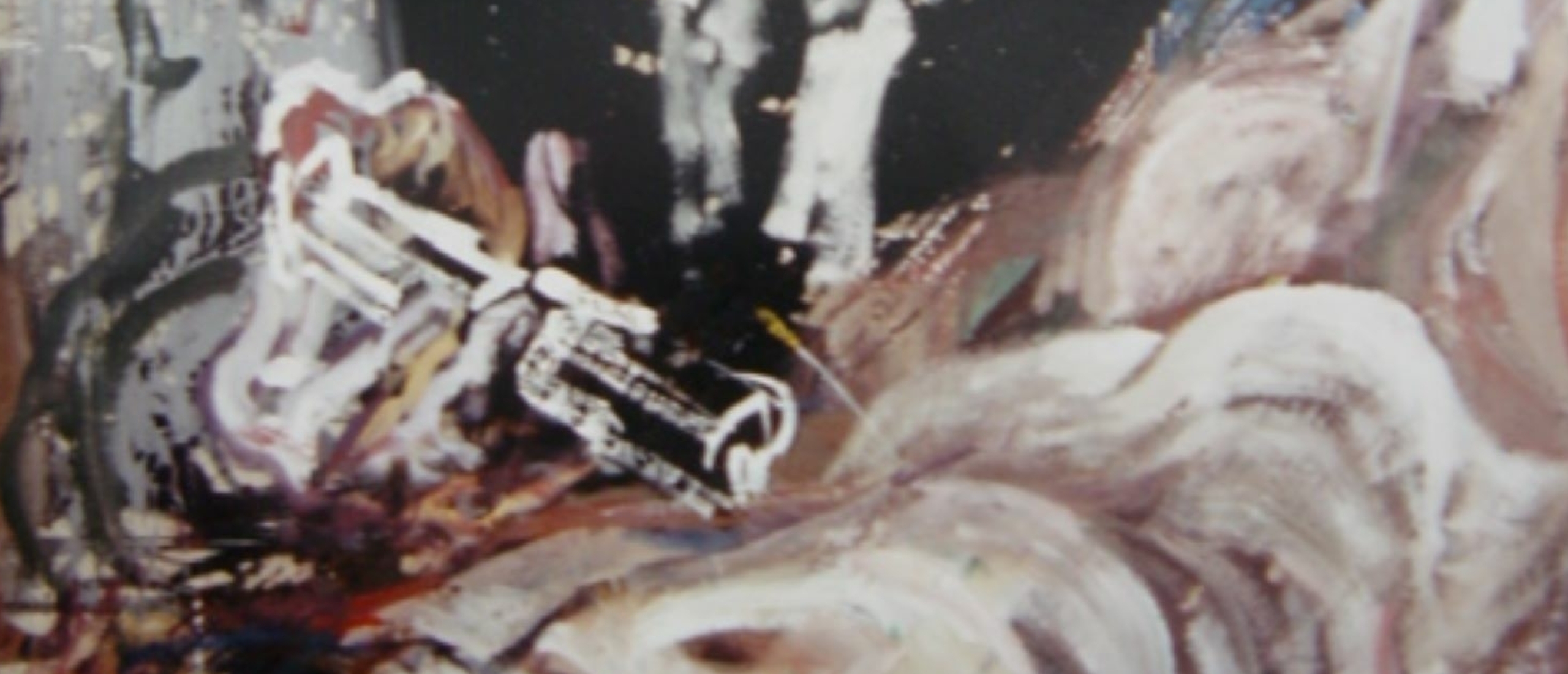
Epidural injection for back pain
By Dr. Jan Claeys, M.D.
Summary of the procedure
In this film we illustrate the procedure of an epidural injection through the hiatus sacralis.
PATIENT'S POSTURE The patient lies prone, both limbs in slight medial rotation and abduction.
PRODUCT For the superficial local anaesthesia : 1 ml lidocaine 2 % without adrenaline. For the epidural local anaesthesia : 50 ml procaine 0.5 % Possibly 20 ml procaine 0.5 % and 5 ml triamcinolone acetonide 10 mg/ml, in case of an insufficient result with 50 ml procaine or in patients who have had a laminectomy.
SYRINGE For the superficial local anaesthesia : 1 ml tuberculin syringe
For the epidural anaesthesia : 50 ml syringe
NEEDLE For the superficial local anaesthesia : 0.6x30 mm (23 G 1/4) For the epidural local anaesthesia 0.7x70 mm (22 G 2 ¾) 0.7x90 mm (22 G 3 ½) in a corpulent patient.
TECHNIQUE. In an epidural injection procaine is injected through the sacral hiatus in the lower part of the epidural space. The distal part of this space has as an outward bound the bony sacral and lumbar canal ; inside are the lower part of the dural tube and the lumbar and sacral nerve roots, covered with dura mater. This space is filled with fat tissue, venous plexuses and loose fibrous tissue. This injection technique can be used without any problem in a private practice. Prior to the injection one should explain the patient that, via a small aperture low in the sacrum, a fluid will be brought in between the disc and the pinched painful nervous structure. After the injection, the patient simply can go home.
1. Palpation, superficial local anaesthesia and insertion of the needle
The patient lies prone on the couch, both limbs in slight abduction and slight medial rotation.
First, one has to find out by palpation if both sides of the upper half of sacrum have the same convexity. Some patients have a very flat sacrum, others a very convex one. Asymmetry is by no means unusual. It is important to know this in advance because a first sign, during the injection, of an extrasacral injection is the appearance of an increasing bulge under the palpating left hand (after about 10 ml).
If too much hair is present, the lower sacrum is shaved. Now the patient is asked to relax the gluteal muscles, while an assistant slightly stretches the skin over the lower sacrum.
Now one tries to palpate two bony prominences just off the midline and under the median sacral crest : the sacral cornua. These are not always easily palpable. In some obese patients they cannot be found and in others one or two cornua are absent.
The sacral hiatus, the distal part of the sacral canal, lies between both cornua. After local superficial disinfection with isopropanol 70°, the skin and the subcutaneous tissue over the hiatus are anaesthetized with 1 ml licocaine 2 % without adrenaline. One should not use more than 1 ml because then the cornua would become less easily palpable. During this superficial anaesthesia, the angle at which the needle pierces the ligament over the hiatus is an indication for inserting the spinal needle.
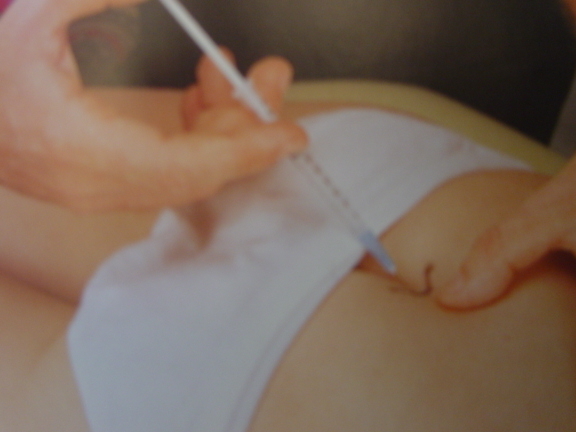 Superficial anaesthesia
Superficial anaesthesia
For the actual epidural injection a spinal needle with a stylet is used.
For the actual epidural injection a spinal needle with a stylet is used. The stylet prevents bringing a piece of skin into the sacral canal, with possible evolution towards a dermoid cyst.
The needle is inserted slightly below the palpating thumb and between both cornua. If these are absent or cannot be felt, one should try and feel the ligament over the hiatus with the tip of the needle. The needle is thrust in through the ligament , parallel to the plane between the cornua and the sacrococcygeal junction. Either the needle slips in some 5-7 cm deep without any resistance, or it hits bone earlier. In which case the angle of the needle should be altered to have a direction parallel to the plane of the mid-sacrum. For that purpose, palpating the sacral spinous processes can be helpful.
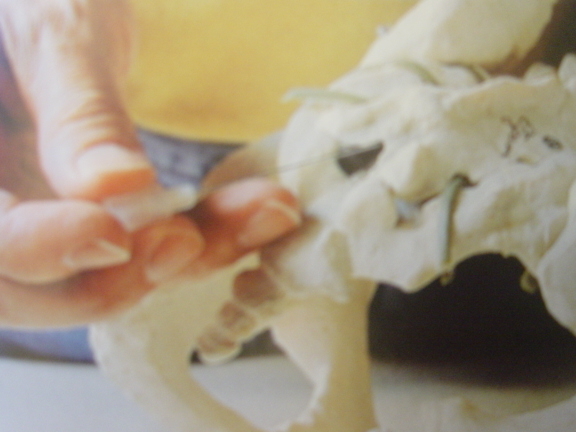 Introducing the needle in the hiatus
Introducing the needle in the hiatus
If the sacrum is very curved, the skin should be punctured well down with the tip of the needle aimed at the patient’s occiput ; for a flat sacrum with prominent cornua, the point of the needle is aimed at the umbilicus. Exceptionally the hiatus sacralis has a prominent bony part. If the needle hits it, it should be slightly withdrawn and reinserted in a somewhat different direction to avoid this bony protuberance. Rarely the patient has an over-curved sacrum, whereby the lower sacral arches are replaced by fibous tissue (bifid sacrum). In this case, the skin should be punctured at S3- level and the depth of the puncture should be adapted at this higher level. In most patients, the dural tube ends level with the lower edge of S1.
To avoid a dural puncture, the needle is inserted to a depth of no more than 5-7 cm ; here, the stylet is withdrawn. In the absence of blood or cerebrospinal fluid on aspiration, the injection can be initiated. If blood is present, the needle should slightly be withdrawn until no further blood appears on aspiration. If cerebrospinal fluid is present, the needle must be removed and a new attempt made a few days later. Then, one should keep in mind that occasionally the dura mater ends at a lower level than the lower edge of S1.
2. The injection
Now the syringe with 50 ml procaine 0.5 % is attached to the needle and suction is applied for blood or cerebrospinal fluid. The speed of the injection must not exceed 5 ml/min. Usually this happens without appreciable resistance and the patient feels only a slight discomfort at the sacrum. Aspiration for blood or fluid is done after each 10 ml. If the injection proves impossible although the needle is correctly placed in the hiatus sacralis, the tip of the needle probably lies subperiosteally. Usually, merely rotating the needle through 180° may suffice, possibly with a slight withdrawal of the needle, and after aspiration a new attempt can be made. If the patient becomes dizzy during the injection, or develops a headache, a pause is called for until these symptoms have passed off. During the injection, the patient should be engaged in some conversation, because a faltering voice is often the first sign of adverse effect. The injection would then have to be interrupted until the patient feels better.
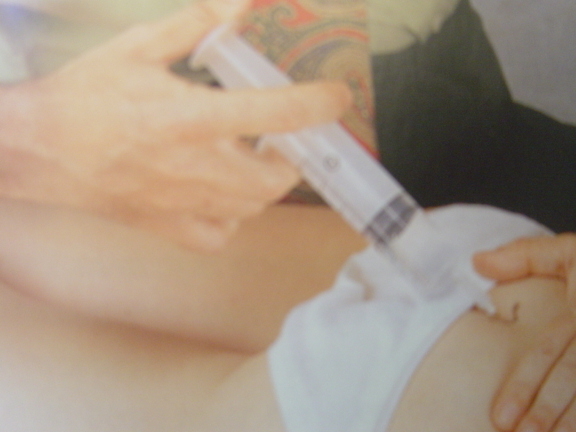 Epidural injection
Epidural injection
An injection, given this way, is for the patient only vaguely unpleasant. This is important, since the patient sometimes needs several injections. During the injection one should keep the free hand flat on the patient’s sacrum, in order to discover quite soon a possible extrasacral injection ; an increasing bulge would then appear under the palpating hand after 10 ml.
In this respect, palpating the sacrum for any asymmetry before the injection is very important. In case of an extrasacral injection the needle should be partly withdrawn and reinserted correctly. During the injection the patient’s blood pressure is regularly checked and the speed of the injection altered accordingly. As the injection continues, most patients feel an ache at the sacrum, sometimes referred to the buttock and the back of the thighs. A patient with sciatica often states that he clearly feels the pain in the limb during the injection : first in the buttock, then in the thigh and eventually in the leg (irritation of the inflamed nerve root by the procaine). This phenomenon is an indirect proof that the needle lies correctly.
The total amount of 50 ml must never be exceeded, not even in very tall patients. For a small slightly built patient, usually no more than 35 ml are injected. Rarely, the patient complains of warm feet during the injection. This indicates that the procaine has reached the L2-level and that the injection can be stopped (influence of the sympathetic nerve). Usually patients over 70 support the injection better than young patients. If the patient feels really odd after 20 ml procaine and this continues for five minutes, the injection must be stopped.
3. After the injection
After the injection the patient lies another 10 min. prone, then slowly turns over supine and further into the sitting position, while having his blood pressure checked. If the patient feels very faint a few minutes after the injection is over, it usually suffices to lie with the legs raised for a while. Twenty minutes after the injection, straight-leg raising or prone lying knee flexion is checked for pain and range. Also the lumbar movements in standing are tested. The more improvement, the better the prognosis. Some 30 min. after the end of the injection, most patients can go home, even driving a car. The only thing they sometimes feel is a temporary numbness in the buttock (S3-S4).
4. Follow-up
The final result of the injection should only be assessed after a week ; the immediate result is very variable. Some patients have more pain during the first few days and then improve rapidly. Others improve initially but relapse at the end of the first week. Others yet have severe pain for a couple of days and then improve slowly. In patients with long-standing sciatica it is best to wait two weeks before assessing the result of the injection. Hence, after one week both the objective signs (prone lying knee flexion or straight-leg raising, and lumbar movements) and the subjective symptoms (pain and mobility) are assessed. A change for the better in either calls for a second injection.
Although usually symptoms and signs improve together, this is not always so. Sometimes straight-leg raising has considerably improved but the patient’s pain has not changed ; sometimes the pain is much less but SLR is unchanged. In both cases, a next injection is called for. If there has been no lasting improvement, a new injection makes no sense.
If the patient still improves, more epidural injections can be given with an interval of one to two weeks. If, exceptionally, after two to three injections, a grossly limited SLR has become normal again but, according to the patient, the pain is unchanged, laminectomy is indicated. For a hyperacute lumbago one injection is enough, followed by daily sessions of manipulation. In chronic backache one to two injections normally suffice.
The SLR test after the first injection has an important prognostic value :if it is full and painless, one more injection should be enough. If it is full but still painful, usually two. If it is still limited and painful, several more injections are needed.
